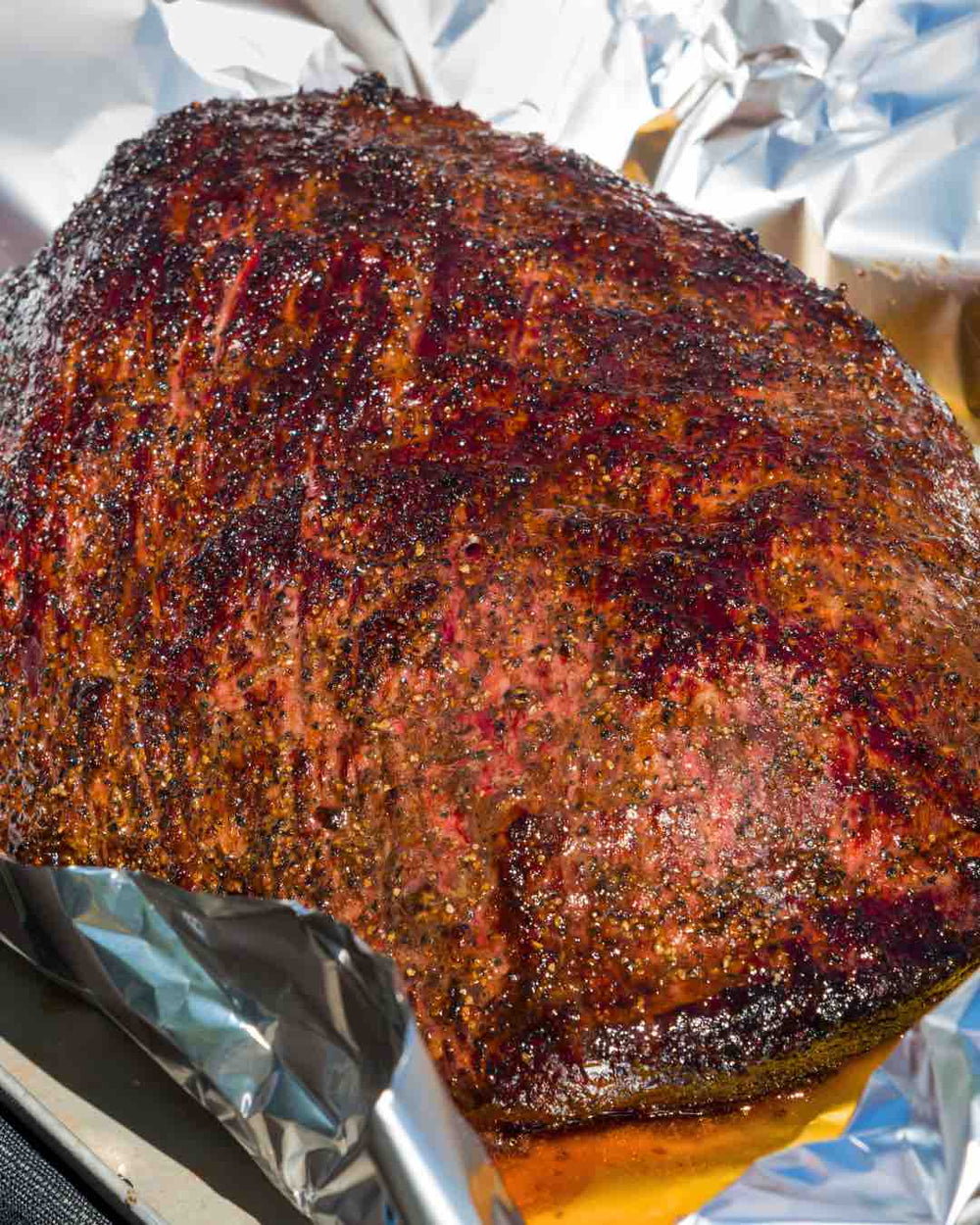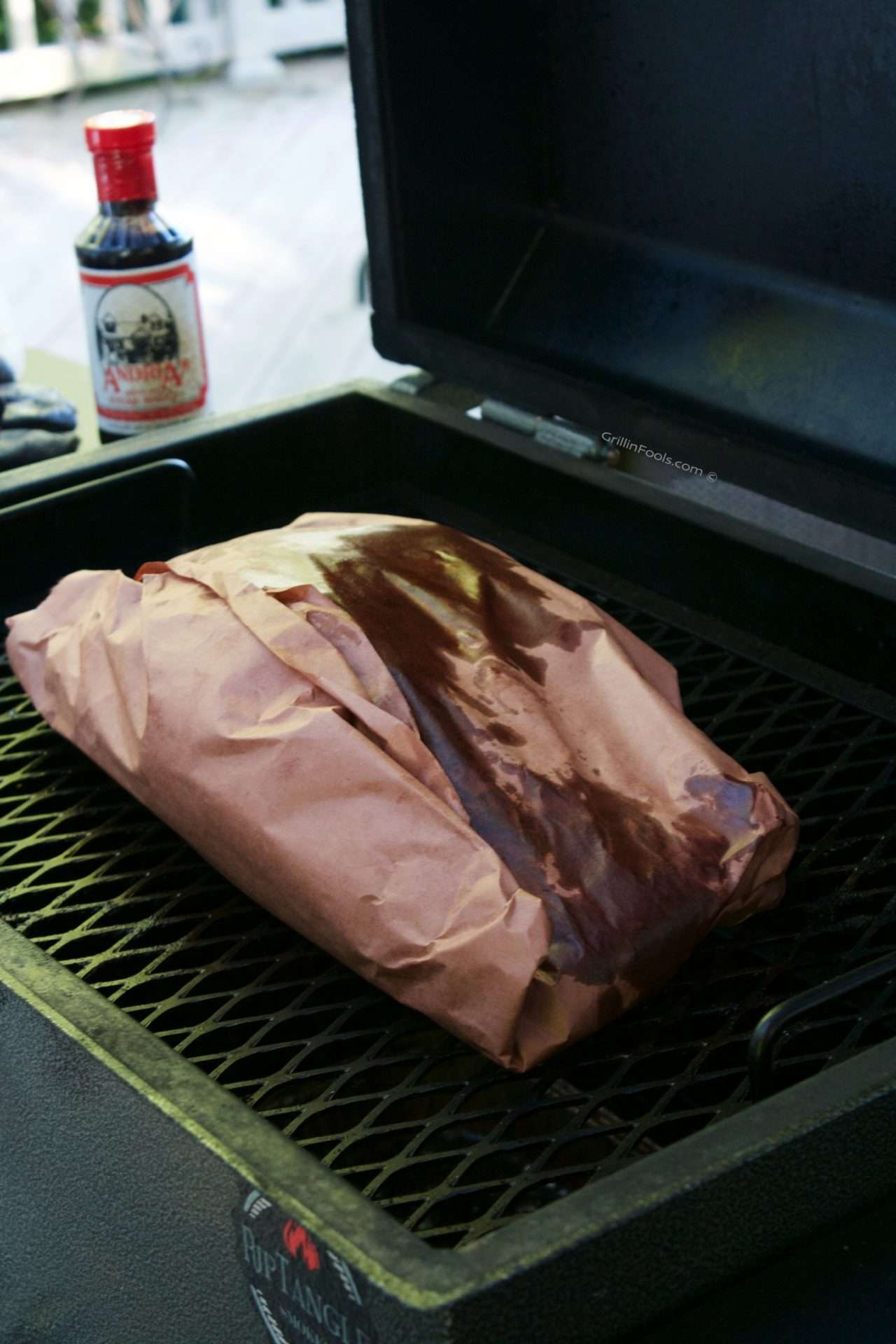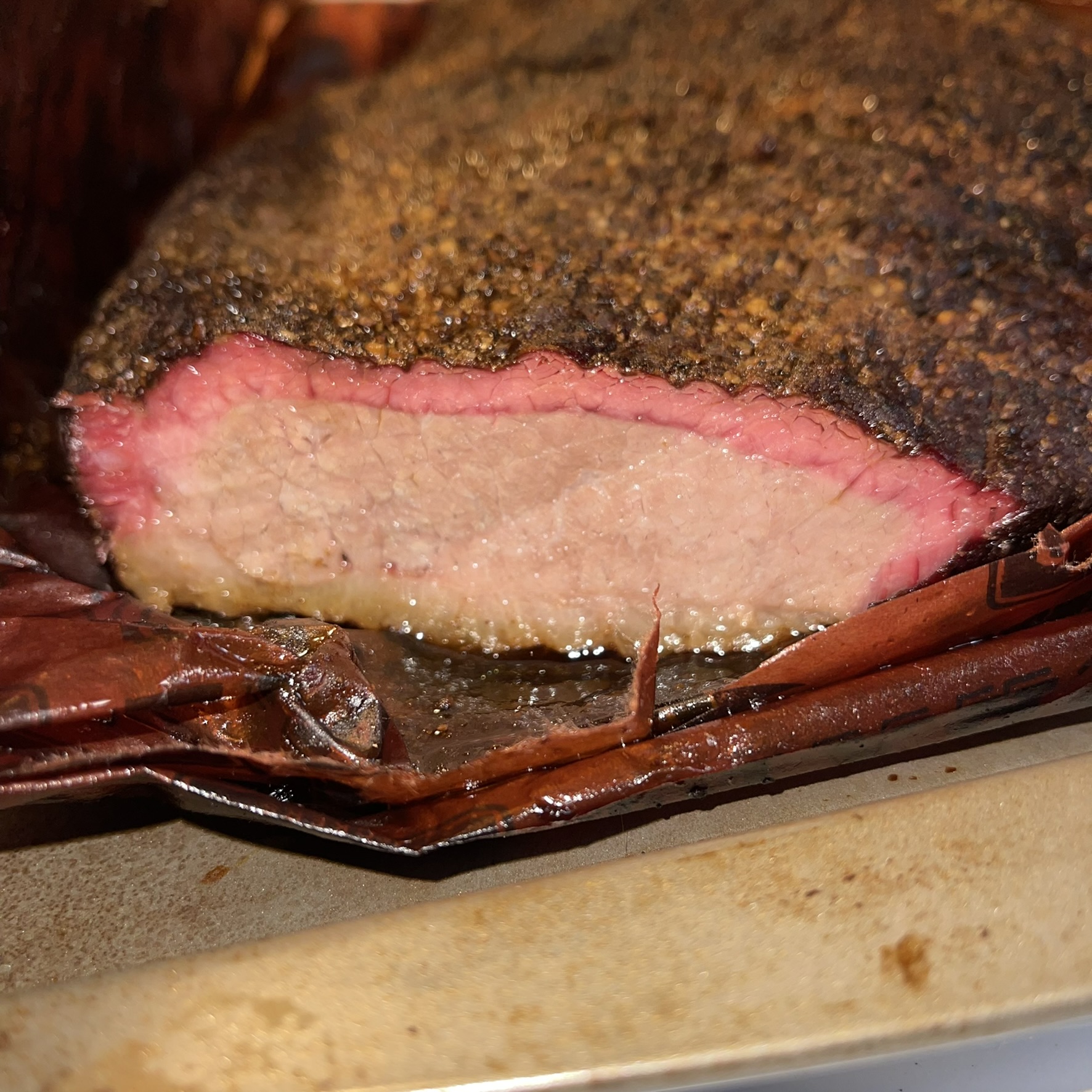
Introduction
Overview Of Wrapping Brisket And Its Impact On The Cooking Process
Wrapping brisket during the cooking process is a popular technique among barbecue enthusiasts. It involves wrapping the meat tightly in aluminum foil or butcher paper to help retain moisture, enhance tenderness, and speed up the cooking time. However, choosing the right temperature to wrap the brisket is crucial in ensuring the best results. Let’s take a closer look at the factors to consider when deciding on the wrapping temperature.
- Size of the Brisket:
- Larger briskets generally require a higher wrapping temperature to ensure thorough cooking and tenderness. The increased temperature helps break down the collagen and connective tissues, resulting in a moist and tender brisket.
- On the other hand, smaller briskets may benefit from a slightly lower wrapping temperature. Cooking them at a lower temperature prevents overcooking and ensures that the meat remains tender and juicy.
- Cooking Time:
- The estimated cooking time for your brisket is another crucial factor to consider when determining the wrapping temperature.
- If you’re cooking a brisket that requires a longer cooking time, such as a whole packer brisket, it’s recommended to wrap it at a lower temperature for a longer period. This allows the meat to cook slowly and evenly, resulting in a tender and flavorful end product.
- For smaller cuts or briskets with a shorter cooking time, wrapping at a slightly higher temperature can help accelerate the cooking process and ensure that the meat is cooked through.
It’s important to note that the wrapping temperature is not an exact science and may vary based on personal preference and the type of equipment you’re using. Experimentation and monitoring the internal temperature of the brisket will help you determine the ideal wrapping temperature for your specific cooking conditions.
Remember, the wrapping temperature is just one element in achieving a perfectly cooked brisket. Factors such as seasoning, smoking technique, and resting time also play a crucial role in the overall flavor and tenderness of the meat. So, happy BBQing and enjoy your deliciously cooked brisket!
Why Wrap A Brisket?
Benefits Of Wrapping Brisket, Including Moisture Retention And Tenderness
Wrapping a brisket during the cooking process offers several advantages that contribute to a delicious end result. Here are some key benefits of wrapping:
- Moisture Retention: Wrapping the brisket tightly in aluminum foil or butcher paper creates a barrier that helps to seal in moisture. This is particularly important during the low and slow cooking process, as the meat tends to lose moisture. The wrapping helps to lock in the natural juices, resulting in a juicy and flavorful brisket.
- Tenderness Enhancement: Wrapping the brisket at the right temperature allows for the breakdown of collagen and connective tissues in the meat. This long, slow cooking process results in a tender and melt-in-your-mouth texture. The wrapped brisket benefits from the slow cooking while being protected from excessive drying out.
- Faster Cooking Time: Wrapping the brisket can help speed up the cooking process. The wrap creates a controlled environment where heat is trapped, causing the brisket to cook more quickly. This can be advantageous when you have time constraints or are cooking for a large group of people.
- Bark Control: The bark, which refers to the flavorful crust that forms on the surface of the brisket, is highly desired by barbecue enthusiasts. Wrapping the brisket can help control the development of the bark, allowing you to achieve the desired level of smokiness and tenderness.
- Flavor Infusion: While wrapping the brisket may result in a slight loss of smoke flavor, most of the smoke flavor is imparted in the first few hours of cooking. The benefits of moisture retention and tenderness enhancement outweigh the minimal impact on smoke flavor.
It’s important to note that the wrapping temperature may vary depending on the size of the brisket and the estimated cooking time. Larger briskets generally require higher wrapping temperatures, while smaller cuts may benefit from slightly lower temperatures. Experimentation and monitoring the internal temperature of the brisket will help determine the ideal wrapping temperature for your specific cooking conditions.
In conclusion, wrapping a brisket during the cooking process offers numerous benefits, including moisture retention, tenderness enhancement, faster cooking time, and bark control. By understanding the factors that influence the wrapping temperature, you can achieve a perfectly cooked brisket with succulent and flavorful results. Happy BBQing!
When To Wrap A Brisket
Determining The Ideal Internal Temperature Range For Wrapping Brisket: 165-170 °F
Wrapping a brisket during the cooking process offers numerous benefits, including moisture retention, tenderness enhancement, faster cooking time, and bark control. Here are the key benefits of wrapping:
- Moisture Retention: Wrapping the brisket tightly in aluminum foil or butcher paper creates a barrier that helps seal in moisture. This is important during the low and slow cooking process to prevent the brisket from losing its natural juices. The result is a juicy and flavorful brisket.
- Tenderness Enhancement: Wrapping the brisket at the recommended internal temperature range of 165-170 °F allows for the breakdown of collagen and connective tissues in the meat. This slow cooking process results in a tender and melt-in-your-mouth texture. The wrapped brisket benefits from slow cooking while being protected from excessive drying out.
- Faster Cooking Time: Wrapping the brisket can speed up the cooking process. The wrap creates a controlled environment where heat is trapped, causing the brisket to cook more quickly. This can be advantageous when there are time constraints or when cooking for a large group of people.
- Bark Control: The bark, which is the flavorful crust that forms on the surface of the brisket, is highly desired by barbecue enthusiasts. Wrapping the brisket helps control the development of the bark, allowing you to achieve the desired level of smokiness and tenderness.
- Flavor Infusion: While wrapping the brisket may result in a slight loss of smoke flavor, most of the smoke flavor is imparted in the first few hours of cooking. The benefits of moisture retention and tenderness enhancement outweigh the minimal impact on smoke flavor.
The wrapping temperature may vary depending on the size of the brisket and the estimated cooking time. Larger briskets generally require higher wrapping temperatures, while smaller cuts may benefit from slightly lower temperatures. Experimentation and monitoring the internal temperature of the brisket will help determine the ideal wrapping temperature for your specific cooking conditions.
Wrapping a brisket during the cooking process offers several advantages, including moisture retention, tenderness enhancement, faster cooking time, and bark control. By understanding the factors that influence the wrapping temperature, you can achieve a perfectly cooked brisket with succulent and flavorful results. Happy BBQing!

How To Wrap A Brisket
Step-by-step Instructions For Properly Wrapping A Brisket Using Either Butcher Paper Or Foil
Once your brisket reaches the ideal internal temperature of 165-170 °F, it’s time to wrap it to reap the benefits of moisture retention, tenderness enhancement, faster cooking time, and bark control. Here’s how to wrap your brisket:
Using Butcher Paper:
- Layout a large sheet of butcher paper on a clean surface, ensuring that it is long enough to wrap around the entire brisket.
- Place your cooked brisket diagonally across the butcher paper, with the fat side facing up.
- Starting from one corner, tightly roll the brisket in the butcher paper, taking care to keep it secure and compact.
- Tuck each end of the butcher paper underneath the brisket to create a sealed package.
- Ensure that the brisket is completely covered by the butcher paper for maximum moisture retention.
Using Aluminum Foil:
- Prepare two arm-length pieces of heavy-duty aluminum foil.
- Lay the foil pieces on top of each other, creating a double layer of foil to prevent any leaks.
- Place your cooked brisket on top of the foil.
- Wrap the foil tightly around the brisket, making sure to seal all edges to trap in the moisture.
Whether you choose butcher paper or aluminum foil, the wrapping process helps create a controlled cooking environment that enhances tenderness, locks in moisture, and allows for faster cooking. It also helps maintain the desired level of bark on the surface of the brisket.
| Wrapping Method | Benefits |
|---|---|
| Butcher Paper | Allows for moisture retention and excellent airflow, resulting in a slightly crisper bark. |
| Aluminum Foil | Creates a more moist and soft texture, and helps in faster cooking due to the trapped heat. |
Ultimately, the choice between butcher paper and aluminum foil comes down to personal preference and desired outcome. Experiment with both methods to find the one that suits your taste and cooking style.
Wrapping your brisket is an essential step in achieving a tender, juicy, and flavorful meat. So, ensure proper wrapping techniques and enjoy the mouthwatering results of your perfectly cooked brisket!
Choosing The Right Wrapping Material
Comparison Between Butcher Paper And Aluminum Foil For Wrapping Brisket
Once the brisket reaches the ideal internal temperature, it’s time to wrap it to benefit from moisture retention, tenderness enhancement, faster cooking time, and bark control. There are two popular options for wrapping brisket: butcher paper and aluminum foil.
Butcher Paper:
- Layout a large sheet of butcher paper on a clean surface, ensuring it is long enough to wrap around the brisket.
- Place the cooked brisket diagonally across the butcher paper, fat side facing up.
- Roll the brisket tightly in the butcher paper, keeping it secure and compact.
- Tuck each end of the paper underneath the brisket to create a sealed package.
- Ensure the brisket is completely covered for maximum moisture retention.
Aluminum Foil:
- Prepare two arm-length pieces of heavy-duty aluminum foil.
- Lay the foil pieces on top of each other to create a double layer, preventing any leaks.
- Place the cooked brisket on top of the foil.
- Wrap the foil tightly around the brisket, sealing all edges to trap in moisture.
Both wrapping methods help create a controlled cooking environment that enhances tenderness, locks in moisture, and allows for faster cooking. The choice between butcher paper and aluminum foil depends on personal preference and desired outcome.
Butcher Paper:
- Allows for moisture retention and excellent airflow, resulting in a slightly crisper bark.
Aluminum Foil:
- Creates a more moist and soft texture and aids in faster cooking due to trapped heat.
Ultimately, experiment with both methods to find the one that suits your taste and cooking style. Wrapping your brisket properly is essential for achieving a tender, juicy, and flavorful meat.
Ensure you follow the wrapping techniques mentioned above, and enjoy the mouthwatering results of your perfectly cooked brisket!
Maintaining A Tight Wrap
Tips For Rolling The Brisket Diagonally And Tucking The Ends To Ensure A Tight Seal
To achieve a tight and secure wrap for your brisket, follow these tips:
- Begin by laying out your chosen wrapping material, whether it’s butcher paper or aluminum foil, on a clean surface.
- For butcher paper, make sure the sheet is large enough to fully wrap around the brisket. For aluminum foil, prepare two arm-length pieces and stack them on top of each other to create a double layer.
- Place the cooked brisket on top of the wrapping material, with the fat side facing up.
- To roll the brisket diagonally, start at one corner of the paper or foil and carefully roll it towards the opposite corner. Apply gentle pressure to keep the brisket tight as you roll.
- Once the brisket is rolled, tuck each end of the wrapping material underneath the brisket. This will create a sealed package that helps retain moisture and heat.
- For butcher paper, ensure that the brisket is completely covered to maximize moisture retention. With aluminum foil, seal all edges tightly to trap in moisture and heat.
By maintaining a tight wrap, you can ensure that the brisket cooks evenly, retains moisture, and develops a flavorful bark.
Remember, the choice between butcher paper and aluminum foil depends on your personal preference and desired outcome. Butcher paper allows for moisture retention and excellent airflow, resulting in a slightly crisper bark. On the other hand, aluminum foil creates a more moist and soft texture and aids in faster cooking due to trapped heat.
Experiment with both methods to find the one that suits your taste and cooking style. Whichever option you choose, be sure to follow the wrapping techniques mentioned above to achieve a tender, juicy, and flavorful brisket.
Enjoy the mouthwatering results of your perfectly cooked brisket by maintaining a tight wrap throughout the cooking process.

Maintaining A Tight Wrap
Tips For Rolling The Brisket Diagonally And Tucking The Ends To Ensure A Tight Seal
To achieve a tight and secure wrap for the brisket, follow these tips:
- Begin by laying out the chosen wrapping material, whether it is butcher paper or aluminum foil, on a clean surface.
- For butcher paper, ensure that the sheet is large enough to fully wrap around the brisket. For aluminum foil, prepare two arm-length pieces and stack them on top of each other to create a double layer.
- Place the cooked brisket on top of the wrapping material, with the fat side facing up.
- To roll the brisket diagonally, start at one corner of the paper or foil and carefully roll it towards the opposite corner. Apply gentle pressure to keep the brisket tight as you roll.
- Once the brisket is rolled, tuck each end of the wrapping material underneath the brisket. This will create a sealed package that helps retain moisture and heat.
- For butcher paper, ensure that the brisket is completely covered to maximize moisture retention. With aluminum foil, seal all edges tightly to trap in moisture and heat.
By maintaining a tight wrap, you can ensure that the brisket cooks evenly, retains moisture, and develops a flavorful bark.
Remember, the choice between butcher paper and aluminum foil depends on personal preference and desired outcome. Butcher paper allows for moisture retention and excellent airflow, resulting in a slightly crisper bark. On the other hand, aluminum foil creates a more moist and soft texture and aids in faster cooking due to trapped heat.
Experiment with both methods to find the one that suits your taste and cooking style. Whichever option you choose, be sure to follow the wrapping techniques mentioned above to achieve a tender, juicy, and flavorful brisket.
Frequently Asked Questions
Common Queries And Answers Related To Wrapping Brisket At The Right Temperature
Q: What is the ideal temperature to wrap a brisket?
A: Most experts recommend wrapping a brisket when its internal temperature reaches between 165-170 degrees Fahrenheit.
Q: What are some tips for achieving a tight wrap?
A: To ensure a tight seal when wrapping a brisket, follow these steps:
- Start by laying out the chosen wrapping material, such as butcher paper or aluminum foil, on a clean surface.
- For butcher paper, make sure it is large enough to fully wrap around the brisket. For aluminum foil, use two arm-length pieces stacked on top of each other for a double layer.
- Place the cooked brisket on top of the wrapping material, fat side up.
- Roll the brisket diagonally from one corner of the paper or foil to the opposite corner, applying gentle pressure to keep it tight as you roll.
- Tuck each end of the wrapping material underneath the brisket to create a sealed package, maximizing moisture and heat retention.
- If using butcher paper, ensure the brisket is completely covered. For aluminum foil, seal all edges tightly to trap moisture and heat.
By maintaining a tight wrap, the brisket will cook evenly, retain moisture, and develop a flavorful bark.
Q: What are the differences between using butcher paper and aluminum foil?
A: Butcher paper allows for moisture retention and excellent airflow, resulting in a slightly crisper bark. On the other hand, aluminum foil creates a more moist and soft texture and aids in faster cooking due to trapped heat.
Q: How do I decide between using butcher paper or aluminum foil?
A: The choice between butcher paper and aluminum foil depends on personal preference and desired outcome. Experiment with both methods to find the one that suits your taste and cooking style.
Remember to follow the wrapping techniques mentioned above to achieve a tender, juicy, and flavorful brisket. Wrapping at the right temperature and maintaining a tight seal will help you achieve the best results.
Conclusion
Recap Of The Importance Of Wrapping Brisket At The Optimal Temperature For Delicious And Tender Results
Wrapping a brisket at the right temperature is crucial to achieving a delicious and tender final result. Here’s a recap of the key points to remember:
- The ideal temperature to wrap a brisket is between 165-170 degrees Fahrenheit.
- To achieve a tight wrap, start by laying out butcher paper or aluminum foil on a clean surface.
- For butcher paper, ensure it is large enough to fully wrap around the brisket. For aluminum foil, use two arm-length pieces stacked on top of each other for a double layer.
- Place the cooked brisket on top of the wrapping material, fat side up.
- Roll the brisket diagonally across the wrap while applying gentle pressure to keep it tight.
- Tuck each end of the wrapping material underneath the brisket to create a sealed package.
- If using butcher paper, ensure the brisket is completely covered. For aluminum foil, seal all edges tightly to trap moisture and heat.
- Butcher paper allows for moisture retention and excellent airflow, resulting in a slightly crisper bark. Aluminum foil creates a more moist and soft texture and aids in faster cooking.
- The choice between butcher paper and aluminum foil depends on personal preference and desired outcome. Experiment with both methods to find the one that suits your taste and cooking style.
Remember, wrapping a brisket at the right temperature and maintaining a tight seal will help the brisket cook evenly, retain moisture, and develop a flavorful bark. Whether you choose to use butcher paper or aluminum foil, the goal is to end up with a tender, juicy, and flavorful brisket. So, follow the recommended wrapping techniques and enjoy the mouth-watering results of your perfectly wrapped brisket.
FAQ: What Temp to Wrap Brisket: Wrapping Wisdom – Choosing the Right Temperature to Wrap Brisket
Q: What does it mean to wrap a brisket?
A: Wrapping a brisket is a technique used in barbecue cooking to help keep the meat moist and tender. It involves wrapping the brisket in foil or butcher paper during the cooking process.
Q: Why is wrapping a brisket important?
A: Wrapping a brisket helps to retain moisture and prevents it from drying out during the lengthy cooking process. It also helps to enhance the tenderness and flavor of the meat.
Q: At what temperature should I wrap a brisket?
A: The ideal temperature to wrap a brisket is usually around 160-170°F (71-77°C). At this point, the brisket’s internal temperature has reached a sweet spot where wrapping it helps to lock in the juices and prevent it from becoming too dry.
Q: Should I wrap my brisket in foil or butcher paper?
A: Whether to use foil or butcher paper for wrapping is a matter of personal preference. Foil provides a tighter seal and helps to retain more moisture, making the meat more tender. However, it can also steam the bark and affect the crunchy texture. Butcher paper allows some airflow while still providing moisture retention, resulting in a slightly firmer bark.
Q: How long should I leave the brisket wrapped?
A: After wrapping the brisket, you should continue cooking until the internal temperature reaches the desired doneness. This could take several more hours. It’s important to monitor the temperature regularly using a meat thermometer.
Q: Can I wrap the brisket too early or too late?
A: Wrapping a brisket too early can result in the loss of the desired bark formation. This may impact the overall texture and flavor. On the other hand, wrapping it too late may make it difficult to achieve the desired tenderness and moisture level. Finding the right timing is crucial for a perfectly cooked brisket.
Q: Can I unwrap the brisket after it has been wrapped?
A: Yes, it is possible to unwrap the brisket after it has been wrapped. Some pitmasters prefer to unwrap the brisket during the final stage of cooking to allow the bark to firm up and develop a smokier flavor. However, it’s important to be cautious as unwrapping too early can cause the brisket to dry out.
Q: How should I store the wrapped brisket?
A: Once the brisket is cooked and wrapped, if you need to store it, place it in an insulated cooler or warming drawer to keep it warm. Alternatively, you can wrap it in foil and place it in a preheated oven at a low temperature (around 150-200°F or 65-93°C). It is important to maintain a safe internal temperature above 140°F (60°C) to prevent bacterial growth.
Q: How can I ensure a successful wrapped brisket?
A: To have the best chance of success, choose a quality brisket, season it well, and monitor the internal temperature throughout the cooking process. Use a meat thermometer to ensure the brisket reaches a safe internal temperature and to determine when it is ready to be wrapped. Experiment with different wrapping techniques and materials to find the one that produces the desired results for your taste preferences.

Noel Martinez, the owner of theholygrillsf.com, uses social media to connect with the community and share delicious updates from The Holy Grill. Follow Noel Martinez for mouthwatering food photos, exciting event announcements, and behind-the-scenes glimpses into the world of The Holy Grill. Stay in the loop and never miss out on the latest culinary adventures!